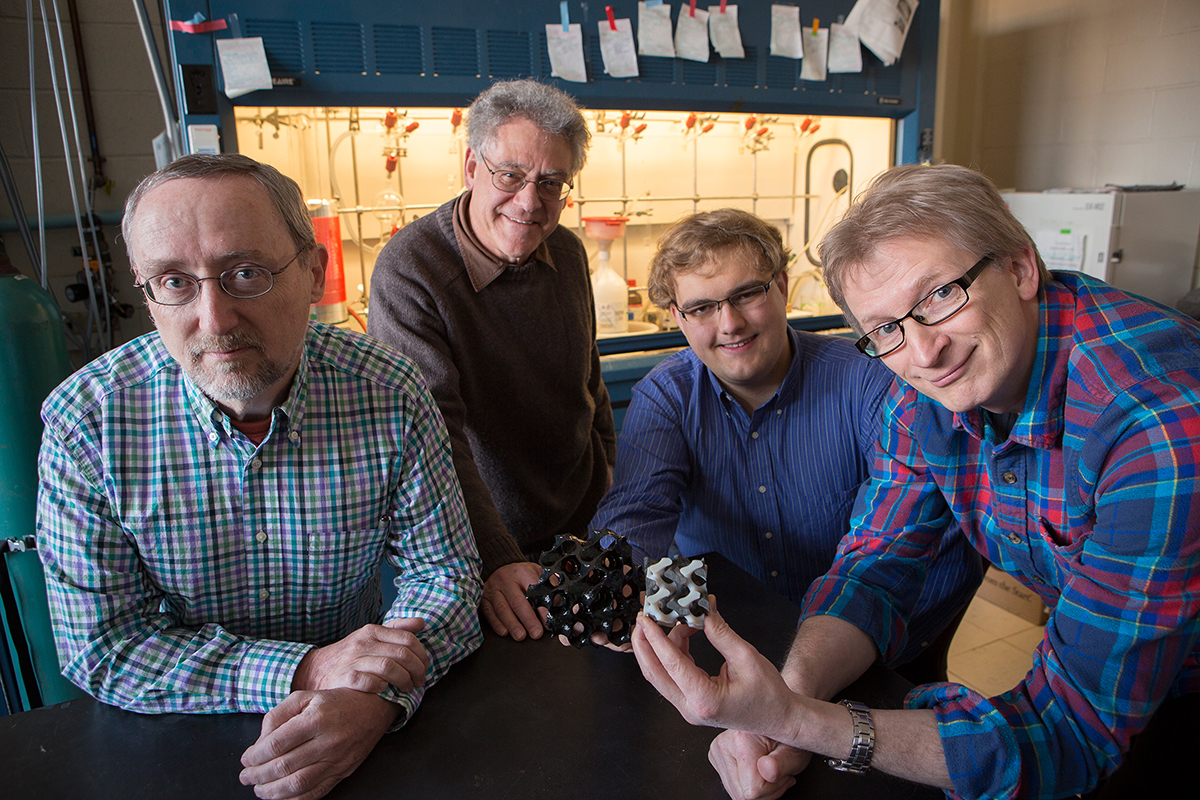First self-assembled superconductor structure created
By Tom Fleischman

Building on nearly two decades’ worth of research, a multidisciplinary team at Cornell has blazed a new trail by creating a self-assembled, three-dimensional gyroidal superconductor.
Ulrich Wiesner, the Spencer T. Olin Professor of Engineering, led the group, which included researchers in engineering, chemistry and physics.
The group’s findings are detailed in a paper published in Science Advances, Jan. 29.
Wiesner said it’s the first time a superconductor, in this case niobium nitride (NbN), has self-assembled into a porous, 3-D gyroidal structure. The gyroid is a complex cubic structure based on a surface that divides space into two separate volumes that are interpenetrating and contain various spirals. Pores and the superconducting material have structural dimensions of only around 10 nanometers, which could lead to entirely novel property profiles of superconductors.
Superconductivity for practical uses, such as in magnetic resonance imaging (MRI) scanners and fusion reactors, is only possible at near absolute zero (-459.67 degrees below zero), although recent experimentation has yielded superconducting at a comparatively balmy 94 degrees below zero.
“There’s this effort in research to get superconducting at higher temperatures, so that you don’t have to cool anymore,” Wiesner said. “That would revolutionize everything. There’s a huge impetus to get that.”
Superconductivity, in which electrons flow without resistance and the resultant energy-sapping heat, is still an expensive proposition. MRIs use superconducting magnets, but the magnets constantly have to be cooled, usually with a combination of liquid helium and nitrogen.
Wiesner and frequent co-author Sol Gruner had been dreaming for over two decades about making a gyroidal superconductor in order to explore how this would affect the superconducting properties. The difficulty was in figuring out a way to synthesize the material.
The breakthrough was the decision to use NbN as the superconductor. This was born from a conversation between Wiesner and Cornell physicist James Sethna, a co-author on the paper. Wiesner recalled asking Sethna what he thought of the possibility of a gyroidal superconductor, and what material should be used.
Sethna, who was writing a paper on superconductors at the time, felt that NbN would be the best option.
Wiesner’s group started by using organic block copolymers to structure direct sol-gel niobium oxide (Nb2O5) into three-dimensional alternating gyroid networks by solvent evaporation-induced self-assembly. Simply put, the group built two intertwined gyroidal network structures, then removed one of them by heating in air at 450 degrees.
The team’s discovery featured a bit of “serendipity,” Wiesner said. In the first attempt to achieve superconductivity, the niobium oxide (under flowing ammonia for conversion to the nitride) was heated to a temperature of 700 degrees. After cooling the material to room temperature, it was determined that superconductivity had not been achieved. The same material was then heated to 850 degrees, cooled and tested, and superconductivity had been achieved.
“We tried going directly to 850, and that didn’t work,” Wiesner said. “So we had to heat it to 700, cool it and then heat it to 850 and then it worked. Only then.”
Wiesner said the group is unable to explain why the heating, cooling and reheating works, but “it’s something we’re continuing to research,” he added.
Limited previous study on mesostructured superconductors was due, in part, to a lack of suitable material for testing. The work by Wiesner’s team is a first step toward more research in this area.
“Now that we have these periodically nanostructured and porous materials, we can start to ask questions about structure property relationships,” he said. “Or we can fill the pores with a second material, that may be magnetic or a semiconductor, and then study the properties of these new superconducting composites with very large interfacial areas.”
This latest effort is groundbreaking in terms of bringing together the organic and inorganic science communities, Wiesner said.
“We are saying to the superconducting community, ‘Hey, look guys, these organic block copolymer materials can help you generate completely new superconducting structures and composite materials, which may have completely novel properties and transition temperatures. This is worth looking into,’” Wiesner said.
Wiesner, whose paper on laser heating-induced structures from block copolymer directed self-assembly was published in Science on July 3, noted that his team’s work points to the collaborative nature of much of the research going on at Cornell. Students, grad students and professors are more identified by their fields of study and not their departments, he said.
“There is a lot of interaction among these different departments, facilitated by the field structure at Cornell,” he said. “At most places, they are siloed, where at Cornell, even the administrative setup is already encouraging and facilitating interdisciplinary research.”
Co-lead authors on the paper, titled “Block copolymer self-assembly directed synthesis of mesoporous gyroidal superconductors,” were Spencer Robbins and Peter Beaucage, graduate students in the fields of chemistry and chemical biology, and materials science and engineering, respectively. Robbins, who graduated in January 2015, is now a materials scientist at San Francisco-based TeraPore Technologies, a startup company out of the Wiesner group.
Other team members included Francis DiSalvo, the John A. Newman Professor of Chemistry and Chemical Biology; Gruner, the John L. Wetherill Professor of Physics; and Bruce van Dover, chair of the Department of Materials Science and Engineering.
The work was supported by grants from the National Science Foundation and the U.S. Department of Energy, and it made use of the Cornell Center for Materials Research Shared Facility, the Cornell High Energy Synchrotron Source, the Cornell NanoScale Science and Technology Facility, and the Kavli Institute at Cornell for Nanoscale Science.
Media Contact
Get Cornell news delivered right to your inbox.
Subscribe